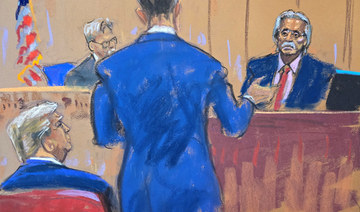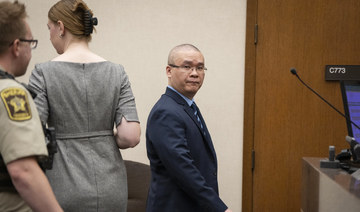LONDON: The battle to become Britain's next prime minister enters the home straight on Wednesday with both candidates hardening their positions on Brexit, putting the future government on a collision course with Brussels.
Ex-London Mayor Boris Johnson, the favourite to replace Theresa May, and Foreign Secretary Jeremy Hunt, are now both referring to Britain's departure with no overall deal in place as a realistic prospect.
The business community and many lawmakers fear dire economic consequences from a no-deal Brexit, which would lead to immediate trade tariffs for some sectors including the automotive industry.
Johnson and Hunt are taking part in a final question-and-answer session later on Wednesday before the result of the vote by Conservative Party members is announced next Tuesday.
The new party leader will be confirmed as prime minister by Queen Elizabeth II on the following day.
Britain has twice delayed its scheduled departure from the European Union after 46 years of membership as May tried and failed to get her deal with Brussels through parliament.
The two candidates vying to replace her have vowed to scrap a "backstop" provision in the agreement that Brussels insisted upon to keep the Irish border open.
Their latest attacks on the measure during a debate on Monday prompted a plunge in the value of the British pound.
The currency fell again Wednesday to its lowest level against the US dollar in over two years.
"The tougher stance from both Boris Johnson and Jeremy Hunt in terms of their rhetoric on Brexit is clearly weighing on the pound," said market analyst Neil Wilson.
"Make no mistake, this decline in the pound is down to traders pricing in a higher chance of a no-deal exit."
The backstop has proved a key stumbling block in the Brexit process.
The measure would keep open the post-Brexit border between British-ruled Northern Ireland and EU member the Republic of Ireland whatever the outcome of negotiations over the future relationship between London and Brussels.
Johnson announced early in his campaign that he would not sign up to it and would pursue a no-deal Brexit if required, leading his opponent to follow suit.
However, European leaders have been adamant that the backstop must remain a part of any divorce deal, raising the prospect of a no-deal Brexit.
German Defence Minister Ursula von der Leyen, who will become European Commission president in November, said the draft withdrawal agreement provided "certainty".
She also broached a possible further delay to Britain's departure, saying: "I stand ready for a further extension of the withdrawal date, should more time be required for a good reason."
Johnson has pledged that under his leadership, Britain will leave "do or die" on the current deadline of October 31.
A majority of lawmakers in the House of Commons are opposed to a no-deal Brexit, but attempts to pass legislation blocking the scenario have failed.
Reports this week suggested Johnson is considering plans to end the current session of parliament in early October, leaving MPs powerless.
Finance Minister Philip Hammond said Wednesday it was "terrifying" that some Brexit supporters thought that no deal would leave Britain better off.
And in a speech in London, May said the "best route" for Britain was to leave with a deal.
Delivering her last major address, she railed against the trend towards "absolutism" in Britain and abroad, and urged her successor to compromise.
"Whatever path we take must be sustainable for the long term, so that delivering Brexit brings our country back together. That has to mean some kind of compromise," she said.
No-deal Brexit looms as race for new British PM wraps up
No-deal Brexit looms as race for new British PM wraps up

- Many lawmakers, business community fear dire economic outcome
- A majority of lawmakers in the House of Commons are opposed to a no-deal Brexit
Rooting for Trump to fail has made his stock shorters millions
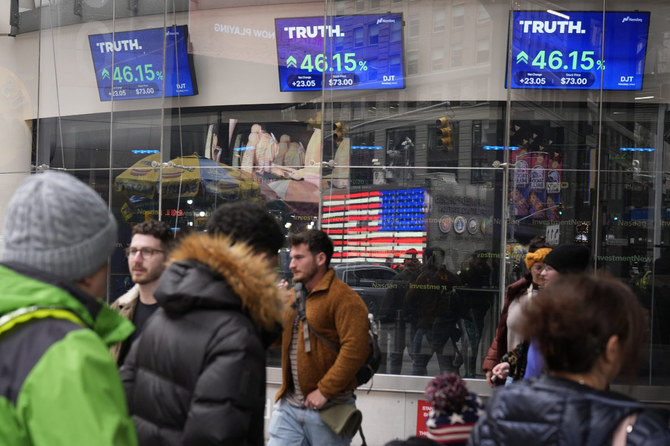
- Wall Street investors have collectively make millions by betting that the stock price of Trump's social media business — Truth Social — will keep dropping despite massive buying by Trump loyalists
NEW YORK: Rooting for Donald Trump to fail has rarely been this profitable.
Just ask a hardy band of mostly amateur Wall Street investors who have collectively made tens of millions of dollars over the past month by betting that the stock price of his social media business — Truth Social — will keep dropping despite massive buying by Trump loyalists and wild swings that often mirror the candidate’s latest polls, court trials and outbursts on Truth Social itself.
Several of these investors interviewed by The Associated Press say their bearish gambles using “put” options and other trading tools are driven less by their personal feelings about the former president (most don’t like him) than their faith in the woeful underlying financials of a company that made less money last year than the average Wendy’s hamburger franchise.
“This company makes no money. ... It makes no sense,” said Boise, Idaho, ad executive Elle Stange, who estimates she’s made $1,300 betting against Trump Media & Technology stock. “He’s not as great a businessman as he thinks. A lot of his businesses go belly up, quickly.”
Says Seattle IT security specialist Jeff Cheung, “This is guaranteed to go to zero.”

As of Friday’s close, a month since Trump Media’s initial public offering sent its stock to $66.22, it has dropped to $41.54. An AP analysis of data from research firms FactSet and S3 Partners shows that investors using puts and “short selling” have paper profits so far of at least $200 million, not including the costs of puts, which vary from trade to trade.
Still, amateur traders, mostly risking no more than a few thousand dollars each, say the stock is too volatile to declare victory yet. So they are cashing in a bit now, letting other bets ride and stealing a glance at the latest stock movements in the office cubicle, at the kitchen table or even on the toilet.
There have been plenty of scary moments, including last week when DJT, the ex-president’s initials and stock ticker, jumped nearly 40 percent in two days.
“I don’t know which direction the stock is going,” says Schenectady, N.Y., day trader Richard Persaud while checking his iPhone amid the surge. “It’s so unbelievably overvalued.”
Many who spoke to the AP say knowing their bets have helped slash the value of Trump’s 65 percent stake in half is an added political benefit. If some of their predictions are right, they may able to someday push it to zero, making it impossible for him to tap it to pay his hefty legal bills or finance his GOP presidential campaign.
They have a long way to go. Trump’s stake is still worth $4 billion.
Normally, investors betting a stock will fall, especially a gutsy breed of hedge fund traders called “short sellers,” will do plenty of homework. They’ll pore over financial statements, develop expertise in an industry, talk to competitors, and even turn to “forensic accountants” to find hidden weaknesses in the books.
No need in Trump Media’s case. It’s all there in the Sarasota, Florida-based company’s 100-page financial report: A firehose of losses, $58 million last year, on minuscule revenue of $4 million from advertising and other sources.
The losses are so big, as Trump Media’s auditor wrote in the report, they “raise substantial doubt about its ability to continue as a going concern.”
A short seller’s dream? Or is it a nightmare?
Amateur trader Manny Marotta has two computer screens at home, one for work, the other showing DJT stock’s movements where he can gauge how much he’s up or down.
It wasn’t looking so good earlier this week.

The legal writer from suburban Cleveland had been up about $4,000 on “put” options purchased over the past few weeks. But the screen that morning was showing investors, presumably rich ones, buying large volumes of DJT shares, pushing up the stock once again.
“My options are worth less with every passing minute,” says Marotta, adding about DJT: “It’s being manipulated. It’s insane.”
Waiting for the stock to drop is especially painful to “short sellers,” who pay a fee to borrow shares owned by others. The idea is to quickly sell them on a hunch they will be able to buy the same number of them later for much cheaper before having to return them to the lender. That allows short sellers to pocket the difference, minus the fee, which is usually nominal.
In DJT’s case, the fee is anything but nominal.
It was costing 565 percent a year at one point earlier this month, meaning short sellers had only two months before any possible profits would be eaten up in fees, even if the stock went to zero. It’s a rate so off the charts, that only three other stocks in recent memory have exceeded it, according to data from Boston University’s Karl Diether and Wharton’s Itamar Drechsler, who have studied short selling back two decades.
Add in massive buying by Trump supporters who see it as a way to support their candidate, and losses could multiply fast.
“It’s scary,” says Drechsler, who likens buyers of Trump’s stock to unwavering sports fans. “It is everything that you hope that the stock market is not.”
Trump Media spokeswoman Shannon Devine said the company is in a “strong financial position” with $200 million in cash and no debt, and said the AP was “selecting admitted Trump antagonists.”
Another danger to the stock is a “short squeeze.” If the price rises sharply, it could set off a rush by short sellers who fear they’ve bet wrongly to return their borrowed shares right away and limit their losses. And so they start buying shares to replace the ones they borrowed and sold, and that very buying tends to work against them, sending the price higher, which in turn scares other short sellers, who then also buy, setting off a vicious cycle of price hikes.
“If DJT starts rallying, you’re going to see the mother of all squeezes,” says S3 Partners short-selling expert Ihor Dusaniwsky, who spent three decades at Morgan Stanley helping investors borrow shares. “This is not for the faint of heart.”
And if that wasn’t enough, there is a final oddball feature of DJT stock that could trigger an explosion in prices, up or down.
“Lock up” agreements prohibit Trump and other DJT executives from selling their shares until September. That leaves the float, or the number of shares that can be traded each day by others, at a dangerously tiny 29 percent of total shares that will someday flood the market. That means a big purchase or sale on any day that would barely move a typical stock can send DJT flying or crashing.
The float is smaller than that of most other notoriously volatile stocks. At their smallest levels, AMC, GameStop and Shake Shack each had more than double the float.
Seattle trader Cheung sees DJT’s freak characteristics as a reason to bet against the stock, not shy away. When the lock-up period ends, he predicts, the ex-president will indeed sell his shares, spooking the market and sending the price down sharply. And even if he doesn’t, other insiders whose lock-ups expire will fear he will do so and will move fast to get a good price before it falls.
“The first one to sell out is going make to most, ” Cheung says. “Everyone is going to sell.”
Still, he doesn’t want to lose money in the interim, so Cheung is offsetting some of his “put” bets with the purchase of “calls.” The latter are also derivatives, but they do the opposite, paying off when the stock rises. Cheung hopes that whichever makes money, the puts or the calls, he will make enough with one to more than make up for the loss of the other.
If all of this seems too complicated, there is a far simpler way to make money betting against Trump.
Offshore, casino-style betting sites are taking wagers on the 2024 election, and some have even made President Joe Biden the favorite.
Dozens of deaths in the US reveal risks of injecting sedatives into people restrained by police
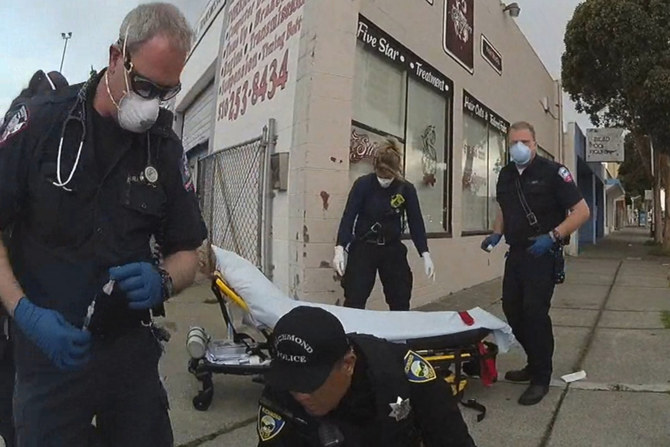
- Joint media probe finds at least 94 people died in the US, half of them blacks, after they were given sedatives and restrained by police from 2012 through 2021
- That’s nearly 10 percent of the more than 1,000 deaths identified during the investigation of people subdued by police in ways that are not supposed to be fatal
Demetrio Jackson was desperate for medical help when the paramedics arrived.
The 43-year-old was surrounded by police who arrested him after responding to a trespassing call in a Wisconsin parking lot. Officers had shocked him with a Taser and pinned him as he pleaded that he couldn’t breathe. Now he sat on the ground with hands cuffed behind his back and took in oxygen through a mask.
Then, officers moved Jackson to his side so a medic could inject him with a potent knockout drug.
“It’s just going to calm you down,” an officer assured Jackson. Within minutes, Jackson’s heart stopped. He never regained consciousness and died two weeks later.
Jackson’s 2021 death illustrates an often-hidden way fatal US police encounters end: not with the firing of an officer’s gun but with the silent use of a medical syringe.
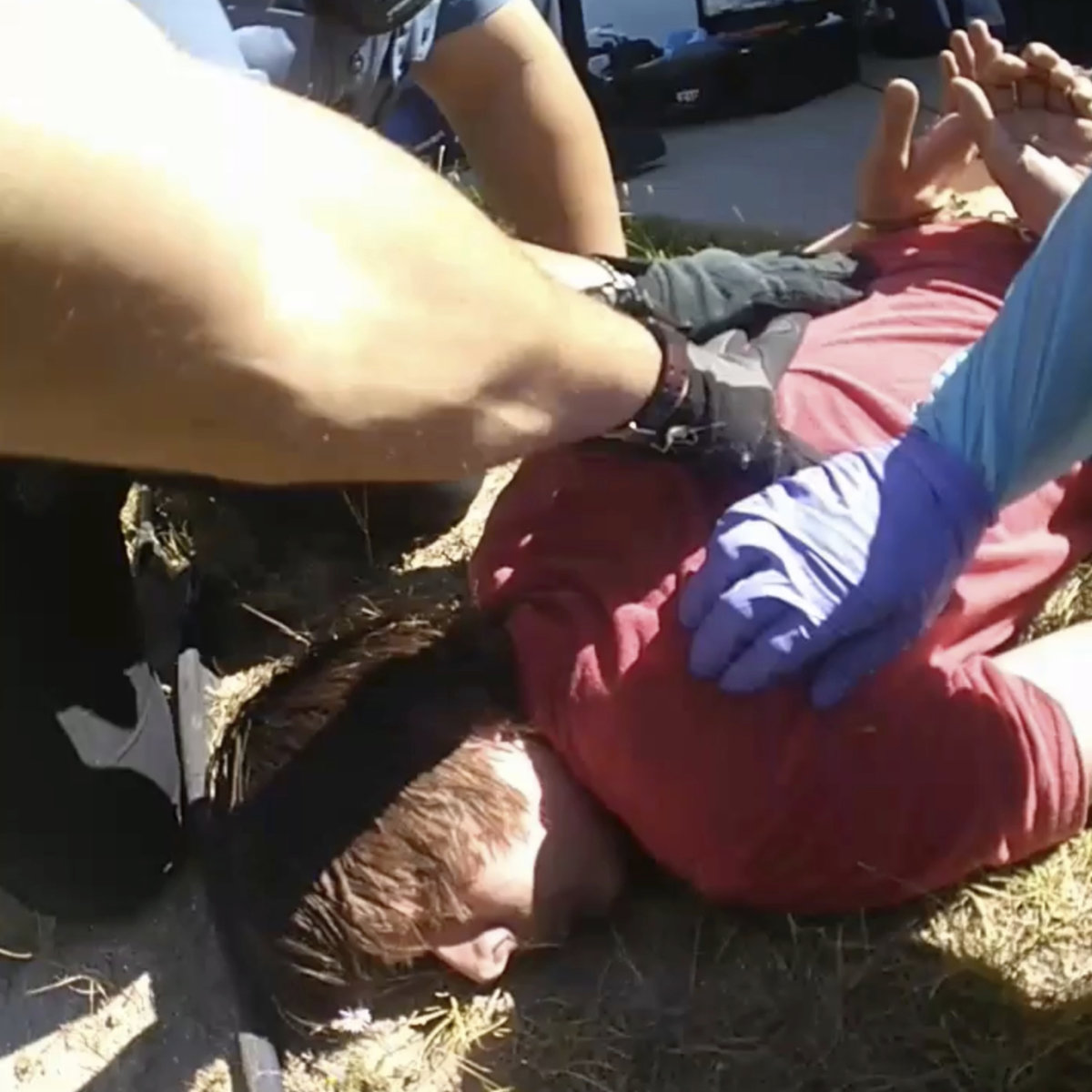
The practice of giving sedatives to people detained by police has spread quietly across the nation over the last 15 years, built on questionable science and backed by police-aligned experts, an investigation led by The Associated Press has found. Based on thousands of pages of law enforcement and medical records and videos of dozens of incidents, the investigation shows how a strategy intended to reduce violence and save lives has resulted in some avoidable deaths.
At least 94 people died after they were given sedatives and restrained by police from 2012 through 2021, according to findings by the AP in collaboration with FRONTLINE (PBS) and the Howard Centers for Investigative Journalism. That’s nearly 10 percent of the more than 1,000 deaths identified during the investigation of people subdued by police in ways that are not supposed to be fatal. About half of the 94 who died were Black, including Jackson.
Behind the racial disparity is a disputed medical condition called excited delirium, which fueled the rise of sedation outside hospitals. Critics say its purported symptoms, including “superhuman strength” and high pain tolerance, play into racist stereotypes about Black people and lead to biased decisions about who needs sedation.
The use of sedatives in half these incidents has never been reported, as scrutiny typically focuses on the actions of police, not medics. Elijah McClain’s 2019 death in Aurora, Colorado, was a rare exception: Two paramedics were convicted of giving McClain an overdose of ketamine, the same drug given to Jackson. One was sentenced last month to five years in prison and the other was sentenced Friday to 14 months in jail and probation.
It was impossible to determine the role sedatives may have played in each of the 94 deaths, which often involved the use of other potentially dangerous force on people who had taken drugs or consumed alcohol. Medical experts told the AP their impact could be negligible in people who were already dying; the final straw that triggered heart or breathing failure in the medically distressed; or the main cause of death when given in the wrong circumstances or mishandled.

While sedatives were mentioned as a cause or contributing factor in a dozen official death rulings, authorities often didn’t even investigate whether injections were appropriate. Medical officials have traditionally viewed them as mostly benign treatments. Now some say they may be playing a bigger role than previously understood and deserve more scrutiny.
Time and time again, the AP found, agitated people who were held by police facedown, often handcuffed and with officers pushing on their backs, struggled to breathe and tried to get free. Citing combativeness, paramedics administered sedatives, further slowing their breathing. Cardiac and respiratory arrest often occurred within minutes.
Paramedics drugged some people who were not a threat to themselves or others, violating treatment guidelines. Medics often didn’t know whether other drugs or alcohol were in people’s systems, although some combinations cause serious side effects.
Police officers sometimes improperly encouraged paramedics to give shots to suspects they were detaining.
Responders occasionally joked about the medications’ power to knock their subjects out. “Night, night” is heard on videos before deaths in California, Tennessee and Florida.
Emergency medical workers, “if they aren’t careful, can simply become an extension of the police’s handcuffs, of their weapons, of their nightsticks,” said Claire Zagorski, a former paramedic and an addiction researcher at the University of Texas at Austin.
Supporters say sedatives enable rapid treatment for drug-related behavioral emergencies and psychotic episodes, protect front-line responders from violence and are safely administered thousands of times annually to get people with life-threatening conditions to hospitals. Critics say forced sedation should be strictly limited or banned, arguing the medications, given without consent, are too risky to be administered during police encounters.
Ohio State University professor Dr. Mark DeBard was an important early proponent of sedation, believing it could be used in rare cases when officers encountered extremely agitated people who needed rapid medical treatment. Today, he said he’s frustrated officers still sometimes use excessive force instead of treating those incidents as medical emergencies. He’s also surprised paramedics have given unnecessary injections by overdiagnosing excited delirium.
Others say the premise was flawed, with sedatives and police restraint creating a dangerous mix. The deaths have left a trail of grieving relatives from coast to coast.
“They’re running around on the streets administering these heavy-duty medications that could be lethal,” said Honey Gutzalenko, a nurse whose husband died after he was injected with midazolam in 2021 while restrained by police near San Francisco. “It’s just not right.”
‘I’m begging you to stop’
Jackson was standing on a truck outside a radio station on the border of the small Wisconsin cities of Eau Claire and Altoona. An employee called 911 before dawn on Oct. 8, 2021, hoping officers could shoo away a stranger who “doesn’t seem to be a threat, but not normal either.”
Police video and hundreds of pages of law enforcement and medical records show how the incident escalated.
An Altoona police officer met Jackson in the parking lot. Jackson appeared uneasy and paranoid, looking around and talking softly. He had taken methamphetamine, which a psychiatrist said he used to self-medicate for schizophrenia. He’d been in and out of jail and living on the streets, with frequent visits to the emergency room seeking a place to rest.
The officer, joined by a second Altoona officer and a sheriff’s deputy, told him he could leave if he gave his name. Jackson refused.
Police identified him through his tattoos, learning he was on probation for meth possession. They noticed the truck had minor damage and decided to arrest him.
Jackson took off running. The officers chased Jackson, who stopped seconds later and staggered toward the first officer. Body-camera video shows she fired her Taser, its darts striking Jackson in the stomach and thigh. He screamed after the electrical shock and collapsed.
When officers couldn’t handcuff Jackson, she fired additional darts, striking Jackson in the back as he lay on the ground. Officers from the Eau Claire Police Department forced Jackson onto his stomach to be handcuffed and restrained him in what’s known as the prone position.
“I’m begging you to stop,” Jackson said. “I can’t breathe.”
After a couple of minutes, officers moved him to his side and then sat him up, trying to improve his breathing.
An officer wondered aloud whether Jackson had “excited delirium” and asked a colleague if paramedics were “going to stand around and do nothing.” He voiced approval when one arrived with ketamine, adding Jackson would not like it “when he gets poked.”
The Eau Claire Fire Department’s excited delirium protocol advises, “Rapid sedation is the key to de-escalation!!!!!” The medic measured 400 milligrams after estimating the 6-foot-tall Jackson weighed 175 pounds, enough to immobilize someone within minutes. He injected the medicine into Jackson’s buttocks.
Five medical experts who reviewed the case for AP said Jackson’s behavior did not appear to be dangerous enough to justify the intervention.
“I don’t believe he was a candidate for ketamine,” said Connecticut paramedic Peter Canning, who said he supports sedating truly violent patients because they stop fighting and are sleeping by the time they get to the hospital.
Minutes later, Jackson stopped breathing on the way to Sacred Heart Hospital. He’d suffered cardiac arrest and, after he was resuscitated, had no brain function.
Jackson’s mother, Rita Gowens, collapsed while shopping at an Indiana Walmart when she learned her oldest son was hospitalized and not expected to survive.

Gowens rushed to the hospital 500 miles away, where she was told he’d been injected with ketamine. She searched online and was stunned to read it’s used to tranquilize horses.
Gowens spoke to Jackson, held his hand and hoped for a miracle. She eventually agreed to remove him from a ventilator after his condition didn’t improve, singing into his ear as he took his final breaths: “You’ve never lost a battle, and I know, I know, you never will.”
She still has nightmares about how police and medics treated her son, whom she recalls as a happy boy with chunky cheeks that inspired the nickname “Meatball.” There are few days when she doesn’t ask, “Why did they give him an animal tranquilizer?”
Ketamine moves to the streets
The practice of using ketamine to subdue people outside hospitals began in 2004 when a disturbed man scaled a fence, cut himself with a broken bottle and paced along a narrow strip of concrete on a Minneapolis highway bridge.
The man was in danger of falling into traffic below when officers reached through the fence and grabbed him.
Dr. John Hick, who worked with first responders, heard the emergency radio chatter while driving and rushed to the scene with an idea. Hick gave the man two shots of ketamine, started an IV and kept him breathing with an air mask.
The man stopped struggling, and responders lowered him to safety.
Paramedics had occasionally used other sedatives to calm combative people since the 1980s. Hick and his Hennepin County Medical Center colleague Dr. Jeffrey Ho believed ketamine worked faster and had fewer side effects, showing promise to avert fatal police encounters.
Ho was a leading researcher on Taser safety and an expert witness for the company in wrongful death lawsuits. In a 2007 deposition in one such case, he argued for a potentially “life-saving tactic” of having sedative injections quickly follow Taser shocks, saying the combination could shorten struggles that, if prolonged, might end in death.
Some doctors at his public hospital in Minneapolis were using “something called ketamine, which is an analog to LSD,” he said. “It’s sort of an animal tranquilizer.”
The drug became more common outside the hospital in 2008 when Hennepin County paramedics were given permission to use it.
An American College of Emergency Physicians panel that included Ho said in 2009 that ketamine had shown “excellent results and safety” while acknowledging no research proved it would save lives.
In time, its use became standard from Las Vegas to Columbus, Ohio, to Palm Beach County, Florida. The earliest death involving ketamine documented in AP’s investigation came in 2015, when 34-year-old Juan Carrizales was injected after struggling with police in the Dallas suburb of Garland, Texas.
Shortly after ketamine became authorized for such use in Arizona in 2017, deputies who were restraining David Cutler facedown in handcuffs in the scorching desert asked a paramedic to sedate him.
The medic testified he was surprised when Cutler stopped breathing, although the dose was larger than recommended for someone weighing 132 pounds. He said he had been trained that ketamine didn’t impact respiration. Cutler’s death was ruled an accident due to heat exposure and LSD — though that was disputed by experts hired by Cutler’s family, who said heat stroke along with ketamine caused his death.
In Minneapolis, an oversight agency found the use of ketamine during police calls rose dramatically from 2012 through 2017 and body-camera video showed instances of officers appearing to pressure paramedics to use ketamine and joking about its power. The department told officers they could never “suggest or demand” the use of sedation.
Facing criticism, Hennepin Healthcare halted a study examining the effectiveness of ketamine on agitated patients. The Food and Drug Administration later found the research failed to protect vulnerable, intoxicated people who had not given consent.
By 2021, the American College of Emergency Physicians warned ketamine impacted breathing and the heart more than previously believed.
“Ketamine is not as benign as we might have hoped it to be,” a co-author of the new position, Dr. Jeffrey Goodloe, said on the group’s podcast in 2022.
He said the practice of giving large doses of ketamine, sometimes too much for smaller patients, had spread nationwide as agencies copied each other’s protocols with little independent review.
But the AP’s findings show risks of sedation go beyond ketamine, which was used in at least 19 cases.
Roughly half of the 94 deaths documented by the AP came after the use of midazolam, which has long been known to heighten the risk of respiratory depression. Many came during police encounters in California, where ketamine is not widely used. Midazolam, a common pre-surgery drug known by the brand name Versed, is also part of a three-drug cocktail used in some states to execute prisoners.
Other cases involved a range of other drugs, including the antipsychotic medications haloperidol and ziprasidone, which can cause irregular heartbeats.
The need for monitoring side effects is often laid out for paramedics in written guidelines, many of which are based on the disputed belief that excited delirium can cause sudden death.
The history of ‘excited delirium’
The theory of excited delirium was troubling from the start.
In the 1980s, with cocaine use soaring, Dr. Charles Wetli, a Miami forensic pathologist, coined the term to explain a handful of deaths of violent cocaine users, many of whom had been restrained by police. Wetli, who died in 2020, also blamed excited delirium for the mysterious deaths of more than a dozen Black women. He said cocaine and sexual activity triggered the fatal condition.
The women’s deaths eventually were attributed to a serial killer. Wetli’s theory survived. And over time, symptoms described by Wetli and others — “superhuman strength,” animal-like noises and high pain tolerance — became disproportionately assigned to Black people. The terms spread to police and emergency medical services to describe certain agitated people — and explain sudden deaths.
By the mid-2000s, police were encountering more drug users and mentally ill people as stimulant use increased and psychiatric hospitals closed. Departments adopted Tasers as a less-lethal alternative to firearms, but there was a problem — hundreds died after being jolted.
Supporters of Wetli’s research, including the medical examiner in Miami-Dade County, ruled again and again that excited delirium was the cause of these deaths, not the effects of the weapons and other physical force. Executives at Taser’s manufacturer agreed, promoting excited delirium to medical examiners around the country and retaining experts who explained the concept to juries in wrongful death lawsuits.
In 2006, a grand jury that investigated Taser-related deaths in Miami-Dade recommended an untested treatment that it said could save people before they died from excited delirium: squirting midazolam up their noses to cause “almost immediate sedation.” Its report acknowledged they “may experience difficulty in breathing.” Miami-Dade paramedics adopted this treatment.
But key medical groups didn’t recognize excited delirium, and activists were calling for limits on Taser use. What happened next would help promote sedation alongside Tasers as tools to gain control.
In 2008, the biggest names in excited delirium research gathered at a Las Vegas hotel for a three-day meeting organized by a group with ties to Taser’s manufacturer.
“A lot of talk took place on chemical sedation because the cops didn’t know what to do with these people,” recalled John Peters, president of the Institute for the Prevention of In-Custody Deaths, which sponsored the meeting. “Jeff Ho had done some work up in Minnesota. He said, ‘Look. I’ve been using ketamine. It knocks them out quicker.’”
The timing was fortuitous: The American College of Emergency Physicians would soon form a task force to study excited delirium and how police and medics should respond.
The 19-member panel included Ho, who became Taser’s medical director under an arrangement in which the company paid part of his hospital salary; Dr. Donald Dawes, a Taser research consultant; and University of Miami researcher Deborah Mash, who testified for Taser about several deaths she blamed on excited delirium. At least two other panelists were routinely retained by officers and their departments as expert witnesses.
The panel’s 2009 paper disclosed none of these relationships. It found excited delirium was real, could result in death regardless of whether someone was shocked with a Taser and called for “aggressive chemical sedation” to treat the symptoms.
DeBard, the now-retired Ohio doctor who chaired the panel, told AP he recruited relevant experts to join and that disclosure of conflicts wasn’t required by the ER doctors group then. He said Taser didn’t influence the outcome, which reflected the panel’s consensus. Mash said she had no conflict because Taser didn’t fund her research. Dawes declined an interview request. Ho didn’t return messages.
Taser rebranded itself in 2017 as Axon. A spokesperson for the company declined interview requests and did not respond to written questions.
Dr. Brooks Walsh, an emergency physician in Connecticut who was not on the panel, said the 2009 paper reinforced racial bias as it formalized “loaded terms” used to describe excited delirium, influencing how the diagnosis would be applied.
Ho and other Taser- and police-aligned experts joined a federally sponsored panel in 2011 that built on the work, recommending four actions on a checklist for officers and paramedics: Identify excited delirium symptoms; control (with a Taser if necessary); sedate; and transport to a hospital.
No test measures for excited delirium, so paramedics faced a judgment call: Which patients were so agitated, strong, impervious to pain and dangerous that they needed to be sedated?
DeBard said the symptoms were based on medical observations, not race. “If you’ve got somebody that’s delirious, irrational, aggressive, hyperactive, running around naked, I mean, it’s really pretty easy” to recognize, he said.
Yet, over time, prominent medical groups and some experts pointed to overuse of sedation during police encounters and a disproportionate impact on Black people. Even supporters of the practice have acknowledged that the wrong patients at times have been injected.
The deaths of Black men in police custody, including the 2020 killing of George Floyd, put pressure on the medical community to re-examine excited delirium. The ER doctors group in 2023 withdrew approval of the 2009 paper and said excited delirium shouldn’t be used in court testimony. Some doctors called that decision political and note the group still recognizes a similar condition — hyperactive delirium with severe agitation — that can be treated with sedation. But today no major medical association legitimizes excited delirium.
‘Convenient for law enforcement’
In more than a dozen cases reviewed by AP, police asked for or suggested the use of sedatives, calling into question whether medics were working for law enforcement or in patients’ interests. Officers often suggested their detainees had excited delirium.
University of California, Berkeley, law and bioethics professor Osagie Obasogie, who has studied excited delirium and sedation, said officers should be banned from influencing medical care.
“We need to be sure that folks are treated in a way that meets their medical needs and not simply given a chemical restraint because it’s convenient for law enforcement,” he said.
Officers are told not to dictate medical treatment but “some knuckleheads” have done otherwise, said Peters, whose group hosted the 2008 Las Vegas meeting that focused on excited delirium.
Paramedics say they make medical decisions independently from police, following guidelines that call for sedating people who may be dangerous. But in several cases AP found, people were injected though they had calmed down or even passed out after struggles with police.
Ivan Gutzalenko, a 47-year-old father, was struggling to breathe as two officers restrained him in Richmond, California. Gutzalenko told the officers they were hurting him, and bucked to try to get one off his back.
A paramedic viewed Gutzalenko’s action as aggression, and went to his ambulance to get a 5-milligram dose of midazolam. When he returned three minutes later, Gutzalenko lay motionless. “He’s faking like he’s unconscious,” an officer said.
The medic plunged the needle into his bicep. Gutzalenko’s heart stopped. He was declared dead at a hospital. A pathologist testified that midazolam was given to “quiet him down” during an episode of excited delirium but did not contribute to the death, which he blamed on prone restraint and meth use.
His wife said Gutzalenko, a former critical care nurse, would never have consented to receive midazolam that day.
“I know from being a registered nurse since 2004, you don’t administer a sedative to someone who is clearly already in respiratory distress,” she said, adding that his death has been devastating to their two teenage children.
Dr. Gail Van Norman, a University of Washington professor of anesthesiology and pain medicine, said it’s dangerous for officers to put pressure on the backs and necks of detainees before and after they’re injected with sedatives.
“It’s a recipe for disaster, because you may have created a situation in which you are impeding a person’s ability to get oxygen,” she said.
The AP investigation found half who died following sedation had been shocked with a Taser and the majority had been restrained facedown.
Their blood acid levels may already have been spiking from drugs, adrenaline and pain while oxygen levels may have been plummeting — life-threatening conditions called acidosis and hypoxia.
Sedatives can dull the instinct to compensate by breathing quickly and heavily to blow off carbon dioxide, essential for the heart to beat, said Dr. Christopher Stephens, a UTHealth Houston anesthesiologist and former paramedic.
Under sedation, he said, the body doesn’t respond as efficiently to the buildup of carbon dioxide. “Your brain doesn’t care as much about it,” Stephens said. “And they can go into respiratory and cardiac arrest.”
Paramedics usually have no idea whether their patients have alcohol, opioids or other depressants in their bodies that increase sedatives’ effects on breathing.
More than a dozen who died had been drinking, including Jerica LaCour, 29, a Colorado Springs, Colorado, mother of five young children.
She was stressed about family finances, husband Anthony LaCour recalled, when deputies found her trespassing at a trucking company.
“Guess who gets ketamine?” paramedic Jason Poulson of AMR, the nation’s largest ambulance company, said as LaCour was restrained on a gurney, according to body-camera footage.
An EMT said in a report that she told Poulson that LaCour had calmed and didn’t need ketamine, and later warned that LaCour was no longer breathing. In a disciplinary agreement with state regulators, Poulson admitted he was unsuccessful in protecting LaCour’s airway despite multiple attempts, mishandled the syringe and failed to document the ketamine use properly. His state certification was put on probation.
AMR and Poulson denied responsibility for LaCour’s death in court filings, arguing LaCour was experiencing excited delirium and ketamine was appropriate. This week they settled a long-pending wrongful death lawsuit, LaCour family attorney Daniel Kay said Friday. He said the settlement amount was confidential and the proceeds would help her children. AMR didn’t immediately respond to a request for comment and a man who answered a cellphone number listed for Poulson hung up on a reporter.
After death, sedation goes unquestioned
When people died, the use of sedation often went unacknowledged publicly and unquestioned by investigators.
After Jackson’s death in Wisconsin, police press releases said nothing about ketamine. State police redacted mention of the drug from investigation records and blurred video of the prone restraint and injection, saying his family’s privacy outweighed the public interest in disclosure.
The fire department, which declined comment, blacked out the information in its incident report. But when AP uploaded the document, redactions disappeared, revealing Jackson was given 400 milligrams of ketamine.
An autopsy concluded Jackson died from complications caused by meth. The report said Jackson’s ketamine dose was 100 milligrams, a quarter of what the fire department report said.
Two longtime forensic pathologists who reviewed the case for AP said meth use wasn’t the only factor. Dr. Joye Carter said she believed the police altercation and ketamine caused the death, saying the sedative can cause heart problems when given to a meth user.
Dr. Victor Weedn said the level of meth in Jackson’s blood was high but generally not lethal. He said Jackson likely died from high blood acid levels, with police restraint and possibly ketamine contributing.
The autopsy was performed in Ramsey County, Minnesota. A county spokesperson defended the findings from a now-retired medical examiner, saying the discrepancy on the ketamine dose wasn’t significant.
Citing the autopsy’s finding that meth was the cause, Eau Claire County District Attorney Peter Rindal ruled Jackson’s case was not an “officer-involved death” under Wisconsin law and closed the investigation.
In nearly 90 percent of the deaths examined by AP, coroners and medical examiners did not list sedation as a cause or contributing factor. Some autopsy reports failed to document that the deceased had been sedated.
The most common ruling was an accidental death in which other drugs, often meth or cocaine, were causes or contributing factors. More than a quarter were at least partially attributed to excited delirium.
Medical examiners view sedatives as safe treatments to control patients and wouldn’t question their use unless there was a grievous error, said Dr. James Gill, the chief medical examiner of Connecticut and past president of the National Association of Medical Examiners.
“Generally we’re going to default then back to what’s the underlying disease or injury that started this chain of events,” Gill said.
He said sedatives rarely cause deaths by themselves but additional studies could look at whether they play a role in fatal police struggles where many factors are involved.
Even when autopsies implicated sedatives, investigations didn’t always follow.
In LaCour’s case, the coroner found she died from “respiratory arrest associated with acute alcohol and ketamine intoxication.” The district attorney’s office said it had no record of reviewing her death.
Nine miles from LaCour’s injection, a paramedic injected 26-year-old Hunter Barr with ketamine as officers held him facedown in the dirt outside his Colorado Springs home in September 2020.
Retired postal worker Mark Barr had called 911 for help controlling his son, who he said wasn’t violent but was having a bad reaction to LSD. He watched as a medic gave two injections just minutes apart. He said he couldn’t figure out why the second injection was necessary, saying his son was subdued. Hunter Barr became unconscious on the way to a hospital and died within hours.
The coroner ruled Barr died from the effects of ketamine. The Colorado Springs Police Department closed the case as “non-criminal” and the DA’s office again had no review.
When deaths were investigated, inquiries usually focused on whether police used excessive force. In audio and video reviewed by AP, investigators seemed uninterested in how sedation may have contributed.
“I’m not trying to get in the weeds with a whole bunch of that,” an investigator told a paramedic explaining the ketamine injection he gave 18-year-old Giovani Berne before Berne’s heart stopped in Palm Bay, Florida, in 2016.
Berne’s sister, Christina, said the family didn’t know he had been given ketamine until contacted by AP years later, but “we knew something bad happened in the ambulance.” A medical examiner ruled that Berne died of excited delirium.
The death of McClain, 23, in Colorado is the only one that resulted in charges against paramedics. Prosecutors argued Aurora paramedics Jeremy Cooper and Peter Cichuniec didn’t assess McClain, gave him too much ketamine for someone his size and didn’t monitor him afterward.
Their convictions shook the EMS field, whose leaders say treatment mistakes shouldn’t be criminalized. Defense attorneys argued the paramedics followed their training on excited delirium and ketamine. A judge gave Cichuniec five years in prison while Cooper was sentenced Friday to 14 months in jail and probation.
Civil liability is also rare, in part because deaths have multiple causes and some courts have ruled that unwilling injections aren’t excessive force even when they cause harm. That hasn’t stopped families from trying: A number of wrongful death lawsuits involving sedation are pending.
Lawmakers in Colorado banned excited delirium as a justification for using ketamine and put other restrictions on the drug, but changes in the law elsewhere have been few.
Paramedic reformers are working to address the failures that increase the risk of sedatives contributing to deaths.
Paramedic Eric Jaeger helped rewrite New Hampshire’s protocols and, at a fire station in Hooksett, recently used Jackson’s death as a training scenario after evaluating the case for AP. He questioned whether sedation was necessary. He said medics failed to thoroughly evaluate Jackson and should have had monitoring equipment ready before any injection.
He said he had been aware of a handful of deaths but the number found by AP “dramatically increases” the scope.
“If we don’t change the training, change the protocols, change the leadership to make the system safer,” Jaeger said, “then we all bear responsibility for future deaths.”
Paris students end Gaza war protests after street fight, New York campus activists vow to continue anti-war camp
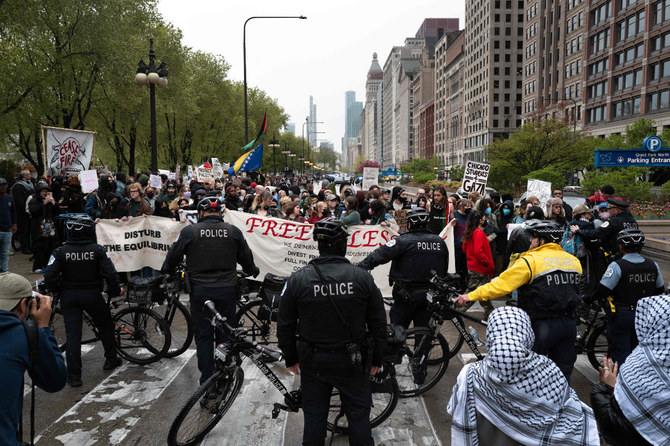
- The Paris protesters called off their action in return for an “internal debate” about the Sciences Po’s ties to Israel
- In New York, Columbia University students said they decided to fight on after reaching an impasse with administrators
PARIS/NEW YORK: Students at one of France’s most prestigious universities on Friday called off protests over the Gaza war after street scuffles between pro-Palestinian and pro-Israeli groups.
Administrators at the Institute of Political Studies, or Sciences Po, university in Paris acted to douse mounting tensions at the Paris establishment as demonstrations spread across American universities over the impact of the Gaza war.
Pro-Palestinian students have staged several days of sit-ins and protests at the 150-year-old university. Some blocked entrances to the university and tents were set up at the central courtyard for a protest camp.
Hundreds of students turned out Friday and police moved in when about 50 pro-Israeli demonstrators arrived shouting and scuffles started.
With exams scheduled to start soon, the university said the pro-Palestinian students had agreed to call off their action in return for an “internal debate” about the university’s ties to Israel.
University authorities also agreed to drop all disciplinary proceedings against demonstrators, said a note sent to students and faculty by Jean Basseres, Sciences Po’s administrator.
Science Po has a joint degree program with New York’s Columbia University and several French students are taking part in protests at one of the US institutions most radicalized by protests.

By Friday night, the Paris protests had eased and the street outside was calm, according to an AFP reporter on the scene.
Protest leaders, who had demanded a study of Science Po’s partnerships with universities or institutions that support the Israeli government, said they were happy with the promise of an internal debate.
France is home to the world’s largest Jewish population after Israel and the United States, as well as Europe’s biggest Muslim community.
The war in Gaza began with an attack by Palestinian militants Hamas on Israel on October 7 that resulted in the deaths of around 1,170 people, mostly civilians, according to an AFP tally of Israeli official figures.
In retaliation, Israel launched a military offensive that has killed at least 34,305 people in Gaza, mostly women and children, according to the Hamas-run territory’s health ministry.
US campus unrest
In New York, Columbia University students who inspired pro-Palestinian demonstrations across the country said that they reached an impasse with administrators and intend to continue their encampment until their demands are met.
The announcement after two days of exhaustive negotiations came as Columbia’s president faced harsh criticism from faculty and puts more pressure on university officials to find a resolution ahead of graduation ceremonies next month — a problem that campuses from California to Massachusetts are facing.
As the death toll mounts in the war in Gaza and the humanitarian crisis worsens, protesters at universities across the country are demanding that schools cut financial ties to Israel and divest from companies they say are enabling the conflict. Some Jewish students say the protests have veered into antisemitism and made them afraid to set foot on campus.
Student negotiators representing the Columbia encampment said that after meetings Thursday and Friday, the university had not met their primary demand for divestment, although there was progress on a push for more transparent financial disclosures.
“We will not rest until Columbia divests,” said Jonathan Ben-Menachem, a fourth-year doctoral student.
Columbia officials had said earlier that talks were showing progress.
“We have our demands; they have theirs,” university spokesperson Ben Chang said, adding that if the talks fail, Columbia will have to consider other options.

Meanwhile, Columbia’s president, Minouche Shafik, faced a significant — but largely symbolic — rebuke from faculty Friday but retained the support of trustees, who have the power to hire or fire the president.
A report by the university senate’s executive committee, which represents faculty, found Shafik and her administration took “many actions and decisions that have harmed Columbia University.” Those included calling in police and allowing students to be arrested without consulting faculty, failing to defend the institution in the face of external pressures, misrepresenting and suspending student protest groups and hiring private investigators.
“The faculty have completely lost confidence in President Shafik’s ability to lead this organization,” said Ege Yumusak, a philosophy lecturer who is part of a faculty team protecting the encampment.
Following the report, the senate passed a resolution that included a task force to monitor how the administration would make corrective changes going forward.
In response, Chang said in the evening that “we are committed to an ongoing dialogue and appreciate the Senate’s constructive engagement in finding a pathway forward.”
Also Friday, student protester Khymani James walked back comments made in an online video in January that recently received new attention. James said in the video that “Zionists don’t deserve to live” and people should be grateful James wasn’t killing them.
“What I said was wrong,” James said in a statement. “Every member of our community deserves to feel safe without qualification.”
Protest organizers said the comments didn’t reflect their values. They declined to describe James’ level of involvement with the demonstration.
Across the country at Arizona State University, protesters pitched tents, including some that police dismantled, and at least one person was handcuffed and taken away.
Police clashed with protesters Thursday at Indiana University, Bloomington, where 34 were arrested; Ohio State University, where about 36 were arrested; and at the University of Connecticut, were one person was arrested.
California State Polytechnic University, Humboldt, has been negotiating with students who have been barricaded inside a campus building since Monday, rebuffing an attempt by the police to clear them out. The campus was shut down at least through the weekend.
On the other end of the state, the University of Southern California canceled its May 10 graduation ceremony a day after more than 90 protesters were arrested on campus. The university said it will still host dozens of commencement events, including all the traditional individual school ceremonies.
Elsewhere in New York, about a dozen protesters spent the night in tents and sleeping bags inside a building at the Fashion Institute of Technology. The institute’s museum, which is in the building where the demonstrators set up camp, was closed Friday.

Protesters also stayed overnight at the encampment at George Washington University. Officials said in a statement that those who remained were trespassing on private property and disciplinary actions would be pursued against students involved in the unauthorized demonstrations.
At Emory University in Atlanta, video that circulated widely on social media showed two women who identified themselves as professors being detained, with one of them slammed to the ground by an officer as a second one pushed her chest and face onto a concrete sidewalk.
University President Gregory Fenves said via email that some videos of clashes were “shocking” and he was “horrified that members of our community had to experience and witness such interactions.”
Fenves blamed the campus unrest on “highly organized, outside protesters” who he said arrived in vans, put up tents and took over the quad. But in an earlier statement, school officials said that 20 of the 28 people arrested were members of the university community.
Since the Israel-Hamas war began, the US Education Department has launched civil rights investigations into dozens of universities and schools in response to complaints of antisemitism or Islamophobia. Among those under investigation are many colleges facing protests, including Harvard and Columbia.
China to host Hamas, Fatah for Palestinian unity talks

- Israel has killed more than 34,000 Palestinians, according to Gaza’s Health Ministry
BEIJING/CAIRO: China will host Palestinian unity talks between Islamist militant group Hamas and its rivals Fatah, the two groups and a Beijing-based diplomat said on Friday, a notable Chinese foray into Palestinian diplomacy amid the war in the Gaza Strip.
Hamas, which controls Gaza, is the group whose fighters stormed into Israeli towns on Oct. 7, killing 1,200 people and capturing 253 hostages. Israel has sworn to annihilate Hamas in an onslaught that has killed more than 34,000 Palestinians.
Fatah is the movement of Mahmoud Abbas, president of the Western-backed Palestinian Authority, which exercises limited self-rule in the Israeli occupied West Bank.
The two rival Palestinian factions have failed to heal their political disputes since Hamas fighters expelled Fatah from Gaza in a short war in 2007. Washington is wary of moves to reconcile the two groups, as it supports the PA but has banned Hamas as terrorists.
A Fatah official told Reuters a delegation, led by the group’s senior official Azzam Al-Ahmed, had left for China. A Hamas official said the faction’s team for the talks, led by senior Hamas official Moussa Abu Marzouk, would be flying there later on Friday.
“We support strengthening the authority of the Palestinian National Authority, and support all Palestinian factions in achieving reconciliation and increasing solidarity through dialogue and consultation,” said Chinese Foreign Ministry spokesperson Wang Wenbin at a regular briefing on Friday, without confirming the meeting.
The visit will be the first time a Hamas delegation is publicly known to have gone to China since the start of the war in Gaza. A Chinese diplomat, Wang Kejian, met Hamas chief Ismail Haniyeh in Qatar last month, according to the Chinese foreign ministry.
The Beijing-based diplomat, who had been briefed on the matter, said the talks aimed to support efforts to reconcile the two Palestinian rival groups.
China has lately demonstrated growing diplomatic influence in the Middle East, where it enjoys strong ties with Arab nations and Iran. Last year, Beijing brokered a breakthrough peace deal between longstanding regional foes Saudi Arabia and Iran.
US Secretary of State Antony Blinken said he discussed with Chinese President Xi Jinping and other officials in Beijing on Friday how China can play a constructive role in global crises, including the Middle East.
Chinese officials have ramped up advocacy for the Palestinians in international forums in recent months, calling for a larger-scale Israeli-Palestinian peace conference and a specific timetable to implement a two-state solution.
In February, Beijing urged the International Court of Justice (ICJ) to give its opinion on the Israeli occupation of the Palestinian Territories, which it said was illegal.
More recently, China has been pushing for Palestine to join the United Nations, which Beijing’s top diplomat Wang Yi said last week would “rectify a prolonged historical injustice.” (Reporting by Nidal Al-Mughrabi and Laurie Chen in Beijing Additional reporting by Ali Sawafta in Ramallah Writing by Nidal Al-Mughrabi Editing by Peter Graff)
Somalia detains US-trained commandos over theft of rations

- The US agreed in 2017 to help train and equip the 3,000-strong Danab to act as a quick-reaction strike force against Al-Shabab
MOGADISHU: Somalia’s government said it had suspended and detained several members of an elite, US-trained commando unit for stealing rations donated by the US, adding that it was taking over responsibility for provisioning the force.
The Danab unit has been a key pillar of US-backed efforts to combat the Al-Qaeda-linked militant group Al-Shabab. The US agreed in February to spend more than $100 million to build up to five military bases for Danab.
Somalia’s Defense Ministry said in a statement that it had notified international partners of the theft and would share the outcome of its investigation.
A US official said in a statement to Reuters that Washington takes all corruption accusations seriously.
“We look forward to engaging with the Danab on creating the necessary safeguards and accountability measures to prevent future incidents that could affect future assistance,” the official said, without directly addressing whether any US support had already been suspended.
The US agreed in 2017 to help train and equip the 3,000-strong Danab to act as a quick-reaction strike force against Al-Shabab.
The group has been waging an insurgency against the central government since 2006.
Danab has been heavily involved in a military offensive by the Somali military and allied clan militias since 2022 that initially succeeded in wresting swaths of territory from Al-Shabab in central Somalia.
However, the campaign has lost momentum, with the government-allied forces struggling to hold rural areas and Al-Shabab continuing to stage large-scale attacks, including in the capital Mogadishu.
Washington suspended some defense assistance to Somalia in 2017 after the military could not account for food and fuel.
The US also conducts frequent drone strikes targeting Al-Shabab militants.





